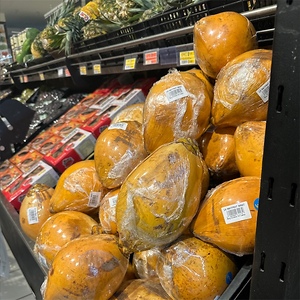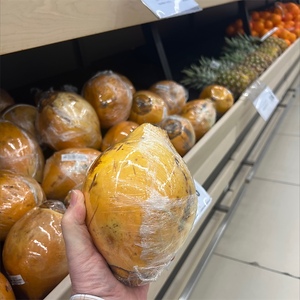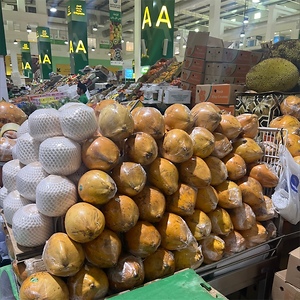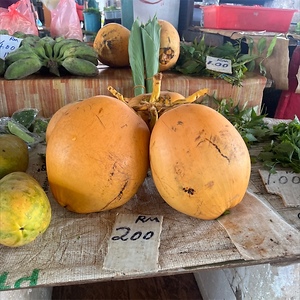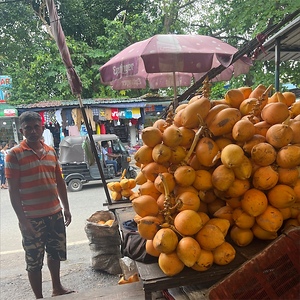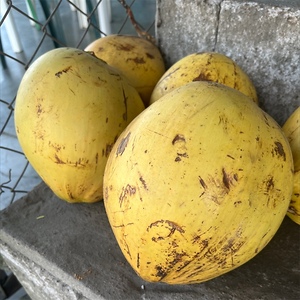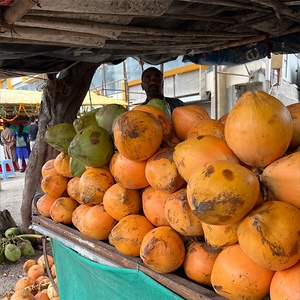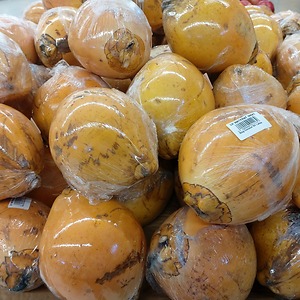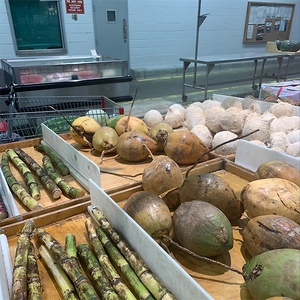

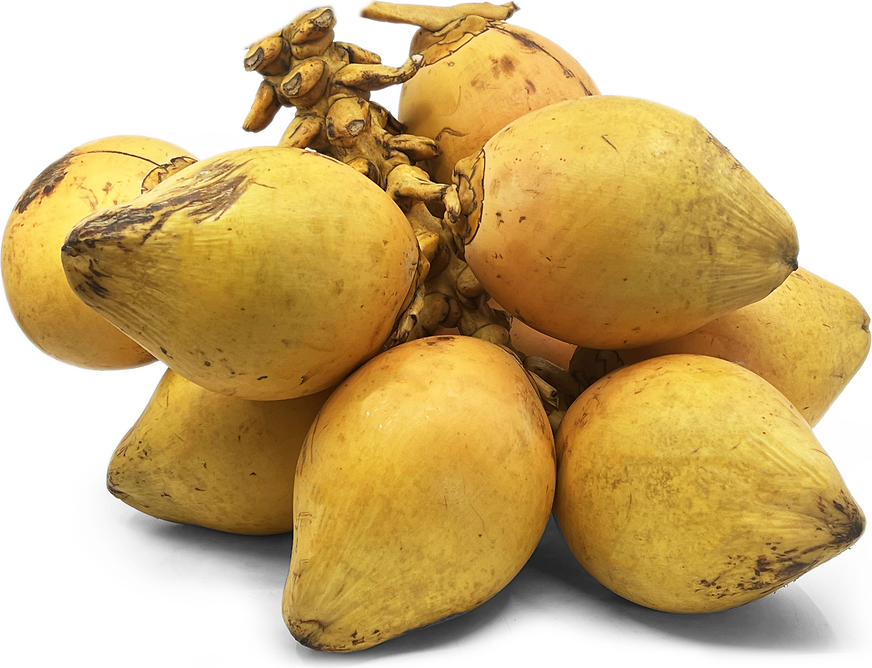
King Coconut
Estimated Inventory, ea : 0
Description/Taste
King coconuts are typically smaller than other coconut varieties and average 20 to 30 centimeters in length. The variety has an elongated, oval shape with a slightly tapered, pointed end opposite the stem. The fruit’s exterior is smooth, taut, and semi-soft, occasionally bearing dark markings naturally acquired through various stages of growth. King coconuts are famous for their golden yellow-orange hues. When young, the coconuts have a vivid, bright yellow-orange coloring, and as they mature, they become firmer, harder, and transition to duller, dark orange-brown shades. Most King coconuts sold in markets are young and showcase a bright hue. Underneath the surface, King coconuts encase a central cavity filled with a clear to light pink liquid, known as the liquid endosperm. Older coconuts also contain a thin layer of white meat, called the solid endosperm, with a tender, spongy, gel-like consistency. King coconuts are primarily sourced for their high-water content and are consumed raw for their rich, sweet, and refreshing liquid. The variety has a naturally lighter flavor and is more delicate than other, more oily, nuttier coconut types.
Seasons/Availability
King coconuts are available year-round.
Current Facts
King coconuts, botanically classified as Cocos nucifera var. aurantiaca, are an Asian cultivar belonging to the Arecaceae family. The variety is one of the most popular coconuts in Sri Lanka and has become known as the island’s “jewel of the tropics.” King coconuts grow on palm trees reaching 20 to 30 meters in height and form in groupings of up to twenty fruits on small branches connected to a long stalk at the top of the tree. The smaller coconuts are hand-harvested to protect their delicate nature and are picked once they have reached 7 to 8 months in maturity. At this age, King coconuts contain the highest water content and will bear the brightest coloring. King coconuts require a much longer period to mature than other varieties of coconuts, but their liquid is filled with higher amounts of hydrating nutritional properties. Throughout Sri Lanka, King coconuts have been revered for their refreshing nature and are widely sold along roadsides and in fresh markets as a beverage. The variety is known as Thambili in Sinhalese, the island’s native language, and roughly translates to “orange,” a descriptor given for the fruit’s exterior. King coconuts are sought for their water over their flesh, which is often consumed directly from the fruit.
Nutritional Value
King coconuts are a source of vitamin C to strengthen the immune system and potassium to balance fluid levels within the body. The variety also contains other nutrients, including calcium, magnesium, and folate. One of the most well-known elements of King coconuts is their high electrolyte content found in the fruit’s liquid. The water is viewed as having cooling properties and contains more electrolytes than other types of coconut water. King coconuts, in general, also contain a higher volume of liquid than other coconuts. In Ayurveda, King coconuts help reduce inflammation and combat overheating. It is also used to support digestion and as a method to boost energy in the morning.
Applications
King coconuts are favored for their refreshing, sweet juice. The fruits are sold whole in markets, and the tops are sliced off and immediately consumed. In Sri Lanka, it is common for King coconuts to be sold as a hydrating beverage, and the water is typically drunk as a stand-alone drink. King coconut water can also be extracted and mixed into smoothies, shakes, cocktails, and other beverages. In addition to the water, the gel-like flesh can be eaten out of hand or combined with the water and frozen into an ice cream. King coconuts are often paired with lime, mint, or chia seeds for enhanced flavoring. King coconuts can be stored for a few weeks at room temperature. Once opened, the water should be immediately consumed for the best quality and flavor, and will keep for three days in the refrigerator.
Ethnic/Cultural Info
King coconuts are often planted near Buddhist temples and shrines throughout Sri Lanka. The brightly colored fruits are revered for their yellow-orange coloring, which is similar to the sacred color of Sinhalese Buddhists. Orange is a traditional hue worn by Buddhist monks, as the color is said to represent the color of illumination and the fire of Buddha’s teachings and knowledge. King coconuts were also valued for their medicinal properties and documented in Buddhist writings and records, which may explain why the trees are planted near temples for practical applications. Outside of Buddhism, King coconuts are a popular village tree, and when new trees are planted, they are sown with salt in honor of the tree’s favored coastal habitat. It is believed that King coconut palms desire to be near the ocean, sometimes growing along water lines, and adding salt to the soil is a symbolic blessing of growth for the tree.
Geography/History
King coconuts are native to Asia and have been growing wild in Sri Lanka since ancient times. The first known record of the variety dates back to the 7th century CE in Buddhist texts and was noted for having religious, medicinal, and cultural uses. King coconuts were eventually sourced from the wild and planted in plantations for increased sales, marking the beginning of their commercial use. Throughout history, King coconuts were a staple variety among indigenous populations. Later in the 19th century, production significantly increased after the establishment of the British colonies on the island. King coconuts were carried on ships as a clean water source and spread worldwide with merchants and trade ships. Today, King coconuts are still primarily localized to Sri Lanka and are grown in a region known as the Coconut Triangle, an area between the cities of Kurunegala, Galle, and Gampaha. King coconuts are also naturally found throughout the wild on the island. Outside of Sri Lanka, King coconut palms may be grown in smaller quantities in tropical, coastal areas. King coconuts are sold fresh and are also exported from Sri Lanka to Europe, North America, and Australia. The King coconuts featured in the photograph above were sourced through Pettah market in Colombo, Sri Lanka.
Recipe Ideas
Recipes that include King Coconut. One
| YouTube |
|
How to Cut King Coconut |



